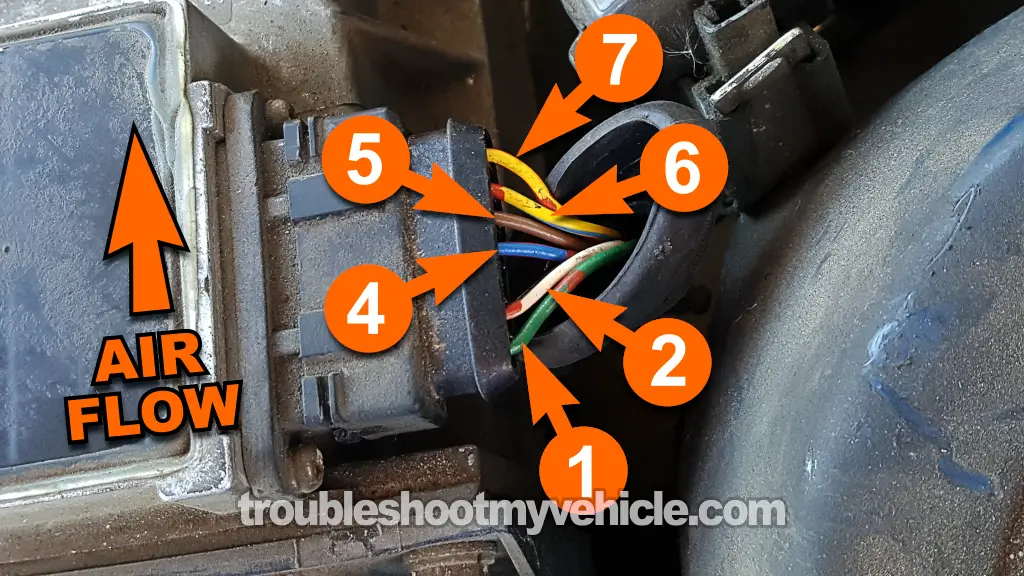TEST 2: Making Sure The MAF Sensor Is Getting Ground

Now that you have confirmed that your Toyota Camry's MAF sensor is getting power, the next step is to make sure it's getting Ground.
Ground is delivered to the MAF sensor by the wire labeled with the number 5 in the photo above. This wire is the brown (BRN) wire of the connector.
We'll do a simple multimeter voltage test to confirm the presence of Ground.
IMPORTANT: The BRN wire connects to the fuel injection computer. Be careful not to pass 12 Volts (from the battery) to this wire, or you'll fry the computer. The multimeter voltage test I'm suggesting below is a safe way to check for the presence of Ground in the BRN wire.
These are the test steps:
- 1
Disconnect the MAF sensor from its electrical connector.
- 2
Place your multimeter in Volts DC mode.
- 3
Turn the key ON but don't crank or start the engine.
- 4
Connect the red multimeter probe to the battery positive (+) post.
- 5
Probe the female terminal that connects to the wire labeled with the number 5 with the black multimeter test lead
The female terminal should connect to the BRN wire. - 6
The multimeter should read 10 to 12 Volts DC.
Let's interpret your test result:
CASE 1: Your multimeter registered 10 to 12 Volts DC. This is the correct and expected test result.
Your next step is to go to: TEST 3: Testing The MAF Signal With A Multimeter.
CASE 2: Your multimeter DID NOT register 10 to 12 Volts DC. This test result tells you that the MAF sensor is not getting Ground. Without Ground, it will not function.
Your next step is to find out why this Ground is missing and restore it.
TEST 3: Testing The MAF Signal With A Multimeter

In this last test, we'll check the MAF signal coming out of the sensor and going to the fuel injection computer.
The wire that carries the MAF signal to your Toyota Camry's fuel injection computer is the yellow with blue stripe (YEL/BLU) wire of the connector. I've labeled this wire with the number 6 in the photo above.
What we're looking for is for the MAF signal voltage to decrease when we accelerate the engine and for it to increase when decelerate the engine
What will tell you that your Toyota Camry's vane air flow sensor is defective will be that the MAF signal will stay stuck in one value as you accelerate the engine.
NOTE: To test the MAF signal, your Camry's vane air flow sensor must be connected to its electrical connector. You'll need to use a back-probe or a wire piercing probe to access the MAF signal. You can see an example of a wire piercing probe here: Wire Piercing Probe.
OK, let's get started:
- 1
Reconnect the MAF sensor to its 7-wire connector.
- 2
Place your multimeter in Volts DC mode.
- 3
Connect the black multimeter probe to the battery negative (-) post.
- 4
Connect the red multimeter test lead to the the wire labeled with the number 6 (see photo above)
This wire should be the the YEL/BLU wire of the connector. - 5
Start the engine and let it idle for about 5 minutes till it reaches its normal operating temperature.
- 6
Accelerate and decelerate the engine as you watch the multimeter's Volts DC readings.
- 7
The voltage reading should decrease when you accelerate the engine and increase when you decelerate the engine.
Idle RPM: 2.3 to 3.8 Volts DC.
3,000 RPM: 1.0 to 2.0 Volts DC.
Let's interpret your test result:
CASE 1: The voltage readings decreased and increased as indicated. This is the correct and expected test result and tells you that the vane air flow sensor (on your Toyota Camry) is working correctly.
CASE 1: The voltage readings DID NOT decrease or increase as indicated. This test result tells you that the vane air flow meter on your Toyota Camry is defective and needs to be replaced.
More 2.0L Toyota Camry Tutorials
You can find a complete list of 2.0L Toyota Camry tutorials and wiring diagrams in this index:
Here's a sample of the tutorials you'll find there:
- TPS Idle Switch Multimeter Test w/ Automatic Transaxle (1987-1991 2.0L Toyota Camry).
- How To Test The TPS w/ Automatic Transaxle (1987-1991 2.0L Toyota Camry).
- How To Test For A Blown Head Gasket (1987-1991 2.0L Toyota Camry).
- How To Test The Engine Compression (1987-1991 2.0L Toyota Camry).
- How To Test The MAF Sensor (1987-1991 2.0L Toyota Camry).

If this info saved the day, buy me a beer!


